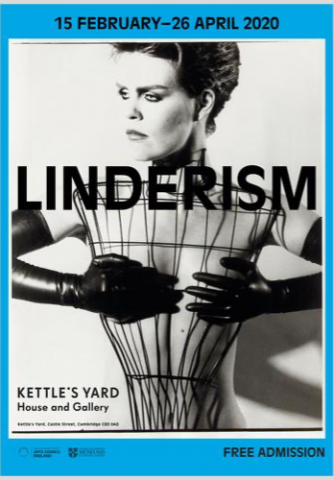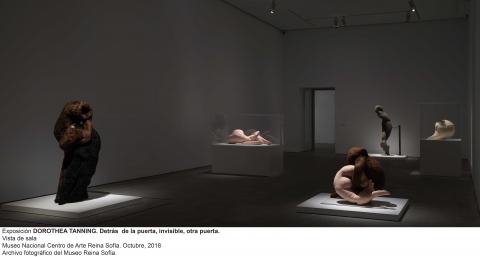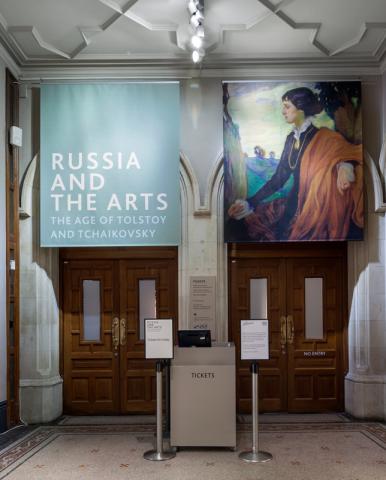Below are some recent exhibitions curated by members of the Department:
Sutapa Biswas
Kettle's Yard, University of Cambridge, 16 October 2021 - 30 January 2022
The exhibition at Kettle’s Yard surveys Biswas’ wide-ranging practice, from early works on paper to photography and moving image that explore belonging, beauty and systems of knowledge and power. Born in India and raised in the UK, Biswas played an important role in anti-racist activism in the British artworld in the 1980s, appearing in landmark exhibitions such as The Thin Black Line, curated by Lubaina Himid at the Institute of Contemporary Art in 1985. Biswas was active at the confluence of Black feminisms and the Black Arts Movement, and her work continues to explore race, gender and identity, as well as family, migration and history.
Biswas first attracted attention as an undergraduate at the University of Leeds for her important mixed-media work, Housewives with Steak-knives (1983–5). On display in the exhibition, the work claims a radical position for Black and South Asian women in British society and questions the limits of western art history. The large two-metre-tall canvas is taken up with a Sutapa Biswas: Lumen 16 October 2021 - 30 January 2022 modernised Kali figure holding the severed head of a white politician in one of her four hands, as well as reproductions of Artemisia Gentileschi’s Judith Beheading Holofernes in another. Housewives with Steak-knives will be shown alongside Biswas’ rarely screened video work Kali (1983–5). In part documentation of a performance, Kali was originally made while Biswas was at Leeds in direct response to the art history teaching she was exposed to there. Biswas attempted to exorcise the imperial legacies of the University’s Fine Art and Art History Department, personified in the form of her tutor, and renowned art historian, Prof Griselda Pollock, who is one of the performers in this work. A collision of references to South Asian, European and North American art, as well as contemporary issues including apartheid animate this important video work.
The works included in the exhibition at Kettle’s Yard engage in different ways with the themes of family, memory, history and time – ideas that have long concerned Biswas, and which also motivate the new film commission Lumen (2020-1). At once explications of experiences of migration, and meditations on love, becoming and desire, Biswas’ work explores fundamental aspects of being as well as the everyday and the banal. In the video Under my table (2006) for instance, Biswas occupies her infant son’s perspective as he plays under a table. Biswas’s still camera captures the movement of the tablecloth in the wind to fantastical mata ne (2015) – a recent filmwork, the title of which translates as ‘return ye to me’, made while on a residency in Beppu, Japan – Biswas captures women speaking about their experiences of life, love and giving birth.
Biswas’ semi-fictional film Lumen, gives the exhibition its title and will show at Kettle’s Yard and BALTIC. Filmed on location in India and England, working with cinematographer Martin Testar, Lumen summons Biswas’ maternal ancestors, through a monologue written by the artist, to retrace her own steps from Bengal. Using rich sound and colour, she evokes memories such as her view from the ship on the journey between Mumbai and Dover. The artist’s personal history overlaps with other maritime histories, from the Atlantic and Indian Ocean slave trades, to post-emancipation British colonial trade and post-colonial migration. The work also implicates the film’s three institutional supporters in these histories: it draws on the material resonances of maritime trade at Kettle’s Yard, in the form of seventeenth-century Delft tiles in the collection, as well as the long histories of transit associated with the Tyne, which flows adjacent to BALTIC. Lumen was also part-filmed in the rich interiors of The Red Lodge Museum, Bristol Museums, that housed prominent Bristolians associated with the Slave Trade and the Abolition Movement. Sutapa Biswas will also partner with the Red Hen Project in North Cambridge on a series of events about literacy. Following on from Kettle’s Yard’s successful collaboration with the Red Hen Project in 2020 resulting in a new publication for children on Alfred Wallis, this new project will also produce a children’s book inspired by Biswas’ work.
Linderism
Kettle's Yard, University of Cambridge, 14 February 2020 – November 2020
A solo exhibition of work by Linder, curated by Amy Tobin. Linder was born in Liverpool in 1954 and was an active figure in the punk and post-punk music scenes. Probably best known for the album covers which she created, her photomontages often combine everyday images taken from fashion or home magazines with images from pornography. Most well known for her photomontage, this exhibition explores the diverse range of Linder’s practice. It explores Linder as performance artist, zine-maker, musician, documentary-photographer, collaborator, muse, guru, medium and body-builder. Through the use of the Kettle’s Yard Archive, Linder also approaches Helen Ede’s elusive presence in Kettle’s Yard. Linder reinstates Helen through the creation of ‘House of Helen’, a brand of products available in the shop. A series of new commissions engage all five senses and see Linder staging interventions in all areas of Kettle’s Yard. The accompanying catalogue with essays by Tobin and Alyce Mahon.
Dorothea Tanning
Reina Sofia Museum, Madrid (Oct 2018-Jan 2019) and the Tate Modern, London (Feb-June 2019)
Dorothea Tanning, the first major retrospective exhibition of American Surrealist Dorothea Tanning (1910-2012), brought over 150 works and documents from global museum and private collections to international audiences in two major institutions – the Reina Sofia Museum and the Tate Modern. Built on three years of primary research on Tanning by Mahon and her established expertise on Surrealism and women of the avant-garde, the exhibition presented 7o years of paintings, drawings, film, sculptures and ballet designs, as well as Tanning’s early advertising work, creative writings and unpublished journals for the first time, ensuring new public and scholarly awareness of a hitherto neglected, but seminal, Surrealist woman artist.
Russia and the Arts: The Age of Tolstoy and Tchaikovsky
National Portrait Gallery, London (17 March - 26 June 2016)
From 2011-2016 Rosalind Polly Blakesley led a five-year collaboration between the National Portrait Gallery, London and the State Tretyakov Gallery, Russia’s national gallery in Moscow. For this she curated and wrote the sell-out catalogue for Russia and the Arts: The Age of Tolstoy and Tchaikovsky, at the National Portrait Gallery; advised on its partner exhibition, From Elizabeth to Victoria: British Portraits from the National Portrait Gallery, at the Tretyakov Gallery (21 April - 24 July 2016), and spearheaded public engagement in both countries, including learning programmes for local communities and schools. Widely praised for the expert cultural diplomacy required to secure iconic paintings never before seen in Britain, Russia and the Arts revealed to over 68,000 people (against a target of 40,000) the intensity with which portraiture mediated relations between theatre, literature, music and painting in the closing decades of Imperial rule.



